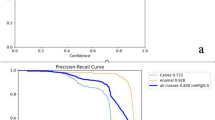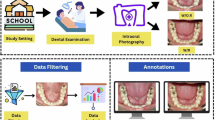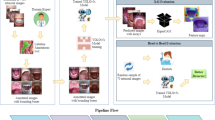Abstract
Objectives
Recent advancements in the You Only Look Once (YOLO) algorithm show promise for dental caries diagnosis. We aimed to evaluate the diagnostic performance of different YOLO versions using photographic and radiographic images for caries detection.
Methods
We searched PubMed (MEDLINE), EMBASE, Web of Science, and Scopus for studies up to December 12, 2024. Studies using any YOLO version for caries detection were included. Binary diagnostic accuracy data were extracted to calculate pooled sensitivity, specificity, and area under the curve (AUC) using a bivariate random-effects model. Quality was assessed with QUADAS-2 and the Radiomics Quality Score (RQS). This review is registered in PROSPERO (CRD42024615440).
Results
We included 15 studies in the systematic review and 14 in the meta-analysis. Overall, YOLO-based models achieved a pooled sensitivity of 79.3% and specificity of 84.9%, with an AUC of 0.832. YOLO using radiographic images demonstrated higher specificity (92.5% vs 72.0%) and AUC (0.847 vs 0.735) than using photographic images, while sensitivity was similar (78.6% vs 80.0%). Differences between YOLO versions (v5 and earlier vs v6 and later) and the use of external validation did not significantly affect diagnostic accuracy.
Discussion
Radiograph-based YOLO models showed superior specificity to photograph-based models, reflecting the higher diagnostic detail of radiographs. However, photographic approaches are completely radiation-free and more accessible, which could benefit screening in low-resource settings. Newer YOLO versions did not significantly outperform older versions, likely due to the limited complexity of the task and dataset constraints in current studies.
Conclusions
YOLO algorithms provide a reliable tool for dental caries detection. Radiograph imaging combined with YOLO offers enhanced diagnostic specificity, while even older YOLO versions remain effective for caries detection in practice.
This is a preview of subscription content, access via your institution
Access options
Subscribe to this journal
Receive 4 print issues and online access
$259.00 per year
only $64.75 per issue
Buy this article
- Purchase on SpringerLink
- Instant access to full article PDF
Prices may be subject to local taxes which are calculated during checkout





Similar content being viewed by others
Data availability
All data analyzed in this study were obtained from previously published articles (the studies included in this systematic review and meta-analysis). The extracted datasets supporting the conclusions of this article are available from the corresponding author upon reasonable request.
References
Ahmad R, Haque M. Oral Health Messiers: Diabetes Mellitus Relevance. Diabetes Metab Syndr Obes. 2021;14:3001–15.
Peres MA, Macpherson L, Weyant RJ, Daly B, Venturelli R, Mathur MR, et al. Oral diseases: a global public health challenge. Lancet. 2019;394:249–60.
Featherstone JD. The science and practice of caries prevention. J Am Dent Assoc. 2000;131:887–99.
Mortensen D, Dannemand K, Twetman S, Keller MK. Detection of non-cavitated occlusal caries with impedance spectroscopy and laser fluorescence: an in vitro study. Open Dent J. 2014;8:28–32.
Petersen PE. Challenges to improvement of oral health in the 21st century–the approach of the WHO Global Oral Health Programme. Int Dent J. 2004;54:329–43.
Pitts NB. Are we ready to move from operative to non-operative/preventive treatment of dental caries in clinical practice?. Caries Res. 2004;38:294–304.
Baelum V. What is an appropriate caries diagnosis?. Acta Odontol Scand. 2010;68:65–79.
Keenan JR, Keenan AV. Accuracy of dental radiographs for caries detection. Evid Based Dent. 2016;17:43.
Krithiga R. A survey: segmentation in dental X-ray images for diagnosis of dental caries. International Journal of Control Theory and Applications. 2016;9:941–8.
Schwendicke F, Samek W, Krois J. Artificial intelligence in dentistry: chances and challenges. J Dent Res. 2020;99:769–74.
Topol EJ. High-performance medicine: the convergence of human and artificial intelligence. Nat Med. 2019;25:44–56.
Moran M et al. Classification of approximal caries in bitewing radiographs using convolutional neural networks. Sensors, 2021;21.
Noor Uddin A, Ali SA, Lal A, Adnan N, Ahmed S, Umer F. Applications of AI-based deep learning models for detecting dental caries on intraoral images – a systematic review. Evid Based Dent. 2025;26:71–72.
Hou S, Zhou T, Liu Y, Dang P, Lu H, Shi H. Teeth U-Net: A segmentation model of dental panoramic X-ray images for context semantics and contrast enhancement. Comput Biol Med. 2023;152:106296.
Tuzoff DV, Tuzova LN, Bornstein MM, Krasnov AS, Kharchenko MA, Nikolenko SI, et al. Tooth detection and numbering in panoramic radiographs using convolutional neural networks. Dentomaxillofac Radiol. 2019;48:20180051.
Thongsakul P, Paing M, Comparison of Deep Learning-based Models for Oral Disease Detection, in 2024 21st International Joint Conference on Computer Science and Software Engineering (JCSSE), Phuket, Thailand, 2024, pp. 187–191.
Redmon J, Divvala S, Girshick R, Farhadi A. You only look once: unified, real-time object detection. in 2016 IEEE Conference on Computer Vision and Pattern Recognition (CVPR). 2016.
Zhang Y, Mao Y, Lu X, Zou X, Huang H, Li X, et al. From single to universal: tiny lesion detection in medical imaging. Artif Intell Rev. 2024;57:192.
Ragab MG. A comprehensive systematic review of YOLO for Medical Object Detection (2018 to 2023). IEEE Access. 2024;12:57815–36.
Kwon O, Yong TH, Kang SR, Kim JE, Huh KH, Heo MS, et al. Automatic diagnosis for cysts and tumors of both jaws on panoramic radiographs using a deep convolution neural network. Dentomaxillofacial Radiology. 2020;49:20200185.
Ding B, Zhang Z, Liang Y, Wang W, Hao S, Meng Z, et al. Detection of dental caries in oral photographs taken by mobile phones based on the YOLOv3 algorithm. Ann Transl Med. 2021;9:1622.
Ha EG, Jeon KJ, Kim YH, Kim JY, Han SS. Automatic detection of mesiodens on panoramic radiographs using artificial intelligence. Sci Rep. 2021;11:23061.
Takahashi T, Nozaki K, Gonda T, Mameno T, Ikebe K. Deep learning-based detection of dental prostheses and restorations. Sci Rep. 2021;11:1960.
Celik ME. Deep learning based detection tool for impacted mandibular third molar teeth. Diagnostics, 2022;12.
Salameh JP, Bossuyt PM, McGrath TA, Thombs BD, Hyde CJ, Macaskill P, et al. Preferred reporting items for systematic review and meta-analysis of diagnostic test accuracy studies (PRISMA-DTA): explanation, elaboration, and checklist. Bmj. 2020;370:m2632.
Whiting PF, Rutjes AW, Westwood ME, Mallett S, Deeks JJ, Reitsma JB, et al. QUADAS-2: a revised tool for the quality assessment of diagnostic accuracy studies. Ann Intern Med. 2011;155:529–36.
Lambin P, Leijenaar R, Deist TM, Peerlings J, de Jong E, van Timmeren J, et al. Radiomics: the bridge between medical imaging and personalized medicine. Nat Rev Clin Oncol. 2017;14:749–62.
Ayhan B, Ayan E, Bayraktar Y. A novel deep learning-based perspective for tooth numbering and caries detection. Clin Oral Investig. 2024;28:178.
Bayraktar Y, Ayan E. Diagnosis of interproximal caries lesions with deep convolutional neural network in digital bitewing radiographs. Clin Oral Investig. 2022;26:623–32.
Cauás N, Millan-Arias C, De Brito DHS, De Oliveira Mota CCB, De Oliveira Da Fonseca MM, Rosenblatt A, et al. Detection of Cavities in Radiographs Using Machine Learning: Approaches for Limited Data. in 2023 IEEE Latin American Conference on Computational Intelligence (LA-CCI). 2023.
Fadhillah ED, Bramastagiri PC, Sigit R, Sukaridhoto S, Brahmanta A, Dewantara BSB. Smart Odontogram: Dental Diagnosis of Patients Using Deep Learning. in 2021 International Electronics Symposium (IES). 2021.
Fitria M, Elma Y, Oktiana M, Saddami K, Novita R, Putri R, et al. The deep learning model for decayed-missing-filled teeth detection: a comparison between Yolov5 And Yolov8. Jordan J Comput Inf Technol. 2024;10:3.
Karakuş R, Öziç M, Tassoker M. AI-assisted detection of interproximal, occlusal, and secondary caries on bite-wing radiographs: a single-shot deep learning approach. J Imaging Inform Med. 2024;37:3146–59.
Khuntia S, Fan SY, Juan PH, Liou CR, Huang YH, Singh K, et al. Empowering portable optoelectronics with computer vision for intraoral cavity detection. IEEE Sensors Journal. 2024;24:25911–9.
Kunt L, Kybic J, Nagyová V, Tichý A. Automatic caries detection in bitewing radiographs: part I-deep learning. Clin Oral Investig. 2023;27:7463–71.
Panyarak W, Suttapak W, Wantanajittikul K, Charuakkra A, Prapayasatok S. Assessment of YOLOv3 for caries detection in bitewing radiographs based on the ICCMS™ radiographic scoring system. Clin Oral Investig. 2023;27:1731–42.
Panyarak W, Wantanajittikul K, Charuakkra A, Prapayasatok S, Suttapak W. Enhancing caries detection in Bitewing Radiographs using YOLOv7. J Digit Imaging. 2023;36:2635–47.
Tareq A, Faisal MI, Islam MS, Rafa NS, Chowdhury T, Ahmed S, et al. Visual diagnostics of dental caries through deep learning of non-standardised photographs using a hybrid YOLO ensemble and transfer learning model. Int J Environ Res Public Health. 2023;20:5351.
Thanh MT, Van Toan N, Ngoc VTN, Tra NT, Giap CN, Nguyen DM. Deep Learning Application in Dental Caries Detection Using Intraoral Photos Taken by Smartphones. Appl Sci. 2022;12:5504.
Zia Uddin SM, Aslam MI, Moinuddin M, Dental Carries Classification Using Yolo V8. J Pop Ther Clin Pharmacol. 2024;31:6.
Ying S, Huang F, Shen X, Liu W, He F. Performance comparison of multifarious deep networks on caries detection with tooth X-ray images. J Dent. 2024;144:104970.
Selwitz RH, Ismail AI, Pitts NB. Dental caries. Lancet. 2007;369:51–9.
Federation FWD. Alcohol as a risk for oral health. Int Dent J. 2024;74:165–6. Feb.
Subedi K, Sigdel B, Khanal PP, Sharma D, Chaudhary G, Singh AK, et al. Dental caries, tobacco usage and associated risk factor of dental caries in patients visiting a government hospital in Western, Nepal. BMC Oral Health. 2024;24:219.
Barillas W, Lee H. Maternal oral health framework: integration of oral health into perinatal care. J Public Health Policy. 2022;43:696–702.
Listl S, Galloway J, Mossey PA, Marcenes W. Global economic impact of dental diseases. J Dent Res. 2015;94:1355–61.
Petersen PE, Bourgeois D, Ogawa H, Estupinan-Day S, Ndiaye C. The global burden of oral diseases and risks to oral health. Bull World Health Organ. 2005;83:661–9.
Oprea AE, Strungaru R, Ungureanu GM. Image processing techniques used for dental x-ray image analysis. 31st International Spring Seminar on Electronics Technology. 2008;2008:125–9.
Ossowska A, Kusiak A, Świetlik D, Artificial intelligence in dentistry-narrative review. Int J Environ Res Public Health, 2022;19.
Rad AE, Amin IBM, Rahim MSM, Kolivand H. Computer-aided dental caries detection system from X-ray images. in Phon-Amnuaisuk S, Au T (eds) Computational Intelligence in Information Systems. Advances in Intelligent Systems and Computing, Vol 331. Springer, Cham; 2015 https://doi.org/10.1007/978-3-319-13153-5_23.
Chapple IL, Bouchard P, Cagetti MG, Campus G, Carra MC, Cocco F, et al. Interaction of lifestyle, behaviour or systemic diseases with dental caries and periodontal diseases: consensus report of group 2 of the joint EFP/ORCA workshop on the boundaries between caries and periodontal diseases. J Clin Periodontol. 2017;44:S39–s51.
Park C, Took CC, Seong JK. Machine learning in biomedical engineering. Biomed Eng Lett. 2018;8:1–3.
Pouyanfar S, Sadiq S, Yan Y, Tian H, Tao Y, Reyes MP, et al. A survey on deep learning: algorithms, techniques, and applications. ACM Comput Surv. 2018;51:92.
Rodrigues JA, Krois J, Schwendicke F. Demystifying artificial intelligence and deep learning in dentistry. Braz Oral Res. 2021;35:e094.
Lee JH, Kim DH, Jeong SN, Choi SH. Detection and diagnosis of dental caries using a deep learning-based convolutional neural network algorithm. J Dent. 2018;77:106–11.
Firestone AR, Sema D, Heaven TJ, Weems RA. The effect of a knowledge-based, image analysis and clinical decision support system on observer performance in the diagnosis of approximal caries from radiographic images. Caries Res. 1998;32:127–34.
Schwendicke F, Göstemeyer G. Conventional bitewing radiography. Clin Dent Rev. 2020;4:22.
Grieco P, Jivraj A, Da Silva J, Kuwajima Y, Ishida Y, Ogawa K, et al. Importance of bitewing radiographs for the early detection of interproximal carious lesions and the impact on healthcare expenditure in Japan. Ann Transl Med. 2022;10:2.
Terry GL, Noujeim M, Langlais RP, Moore WS, Prihoda TJ. A clinical comparison of extraoral panoramic and intraoral radiographic modalities for detecting proximal caries and visualizing open posterior interproximal contacts. Dentomaxillofac Radiol. 2016;45:20150159.
Saini D, Jain R, Thakur A. Dental Caries early detection using Convolutional Neural Network for Tele dentistry. in 2021 7th International Conference on Advanced Computing and Communication Systems (ICACCS). 2021;958–963.
Oakley PA, Harrison DE. Radiophobia: 7 reasons why radiography used in spine and posture rehabilitation should not be feared or avoided. Dose Response. 2018;16:1559325818781445.
Al-Jallad N, Ly-Mapes O, Hao P, Ruan J, Ramesh A, Luo J, et al. Artificial intelligence-powered smartphone application, AICaries, improves at-home dental caries screening in children: Moderated and unmoderated usability test. PLOS Digit Health. 2022;1:e0000046.
Gupta S, Nair S. A review of the emerging role of UAVs in construction site safety monitoring. Mater Today: Proc. 2023. https://doi.org/10.1016/j.matpr.2023.03.135.
Wang CH, Tay J, Wu CY, Wu MC, Su PI, Fang YD, et al. External validation and comparison of statistical and machine learning-based models in predicting outcomes following out-of-hospital cardiac arrest: a multicenter retrospective analysis. J Am Heart Assoc. 2024;13:e037088.
Collins GS, Reitsma JB, Altman DG, Moons KG. Transparent reporting of a multivariable prediction model for individual prognosis or diagnosis (TRIPOD): the TRIPOD statement. Bmj. 2015;350:g7594.
Moons KGM, Wolff RF, Riley RD, Whiting PF, Westwood M, Collins GS, et al. PROBAST: A Tool to Assess Risk of Bias and Applicability of Prediction Model Studies: Explanation and Elaboration. Ann Intern Med. 2019;170:W1–w33.
Mei J, Zhu W. BGF-YOLOv10: small object detection algorithm from unmanned aerial vehicle perspective based on improved YOLOv10. Sensors. 2024;24:6911.
Acknowledgements
The authors thank the support of their respective institutions. The authors also thank colleagues for helpful discussions and feedback during the preparation of this manuscript.
Funding
No specific grant from any funding agency in the public, commercial, or not-for-profit sectors was received for this research.
Author information
Authors and Affiliations
Contributions
Q.T.L. conceived and designed the study. Q.T.L. and M.H.N.L. performed the literature search and screening. Q.T.L. extracted the data and conducted the meta-analysis, while M.H.N.L. cross-checked the data and performed the quality assessments. N.Q.K.L. and I.-T.L. provided methodological guidance and helped resolve any discrepancies during the review process. All authors contributed to the interpretation of results. Q.T.L. drafted the manuscript, and M.H.N.L., N.Q.K.L. and I.-T.L. critically revised it. All authors read and approved the final manuscript.
Corresponding authors
Ethics declarations
Competing interests
The authors declare no competing interests.
Additional information
Publisher’s note Springer Nature remains neutral with regard to jurisdictional claims in published maps and institutional affiliations.
Supplementary information
Rights and permissions
Springer Nature or its licensor (e.g. a society or other partner) holds exclusive rights to this article under a publishing agreement with the author(s) or other rightsholder(s); author self-archiving of the accepted manuscript version of this article is solely governed by the terms of such publishing agreement and applicable law.
About this article
Cite this article
Lam, Q.T., Le, M.H.N., Lee, IT. et al. Evaluating YOLO for dental caries diagnosis: a systematic review and meta-analysis. Evid Based Dent (2025). https://doi.org/10.1038/s41432-025-01180-1
Received:
Revised:
Accepted:
Published:
DOI: https://doi.org/10.1038/s41432-025-01180-1



